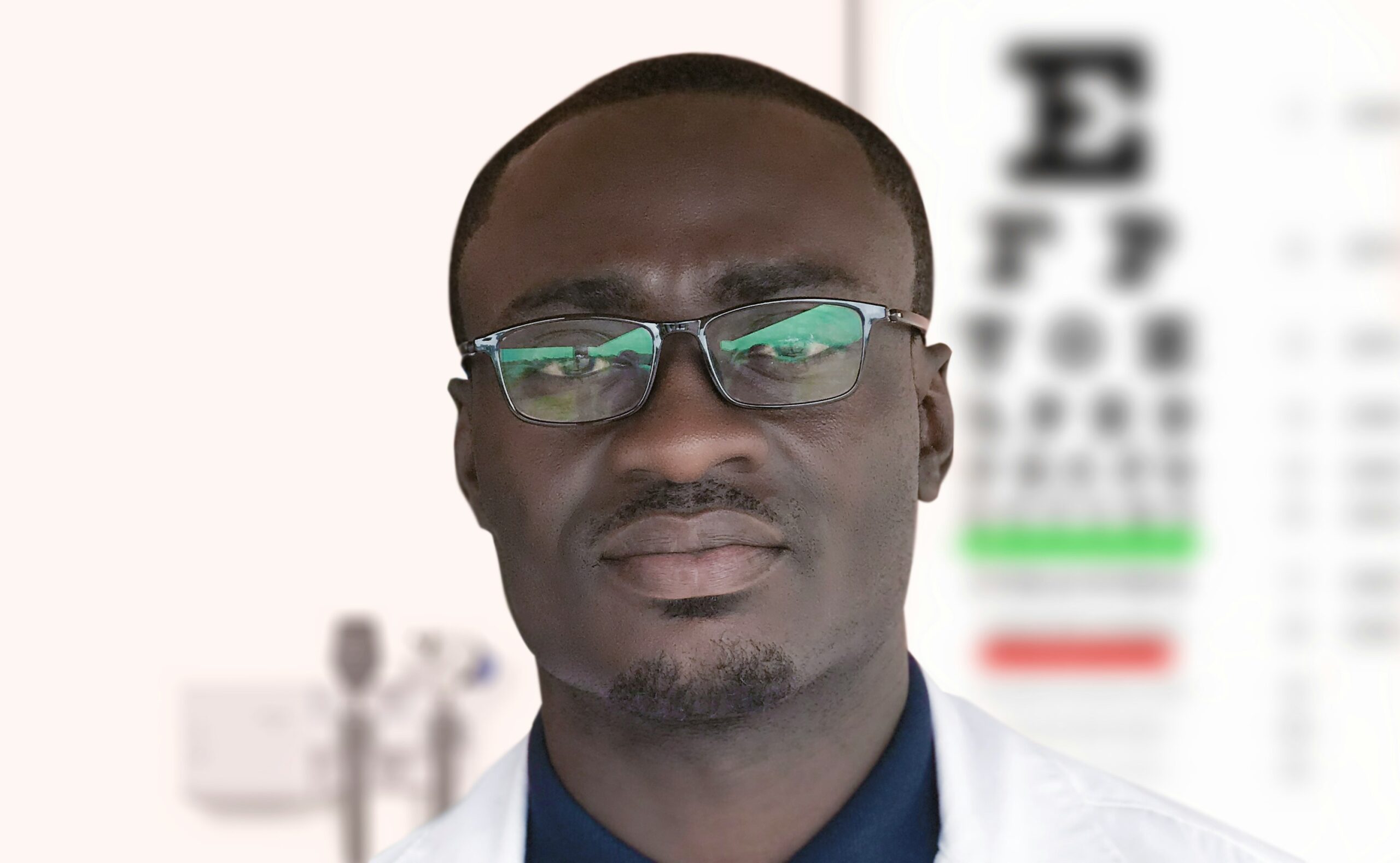Blurry vision is a symptom that can have various causes. Blurred vision is the general term used when it is difficult to see details. The visual disturbance may affect one or both eyes, develop gradually, or occur suddenly. Visual problems are relatively common.
Their appearance is usually determined by the patient's pre-existing visual impairment or eye disease. In each case, the symptom makes daily functioning difficult and causes discomfort and anxiety.

The diagnosis and treatment of hazy vision depends on the cause of the symptom. The first step is usually an ophthalmic examination, which can identify vision problems. Additional tests may be necessary to determine the cause of a visual defect that is not detected. Could blurry vision be an indication of a severe medical condition? Find out more about the symptoms of blurry vision.
First, it is worth defining what precisely the term blurry vision means. The symptom is a specific visual sensation described as blurred, out of focus, or seeing through a fog. Blurry vision prevents you from seeing the contours of people and objects. It most often affects objects that are far away. However, blurry vision can also occur when looking at objects up close. It all depends on the cause of the blurry vision. The most common causes are visual impairments, but the symptoms can also indicate systemic diseases. Here are the possible causes of blurry vision:

Myopia is a visual defect in which the eye's optical path focuses the image in front of the retina, so objects at a distance are seen as blurry. In contrast, objects at a short distance can be seen well. Short-sightedness can be corrected with the right choice of lenses, spectacles, and glasses. However, the earlier the onset of myopia at an earlier age, the greater the risk that it will develop to a high or pathological level. The causes of myopia are related to several factors, such as genetics, habits, disease, and trauma. What mainly causes blurry vision is the eye's optical system and the eyeball's length.
It is another common visual impairment that can be corrected with contact lenses or glasses. If you are hyperopic, you can see farther away objects clearly, and objects closer to you may be less clear. When you are young, the eye's natural ability to accommodate can partially compensate for this defect. Still, as you get older, this ability decreases, which results in more difficulty seeing up close and far away. Farsightedness can result from various causes, such as anatomical optics, genetic, pathological, or environmental factors.
Astigmatism is one of the most common eye defects that cause blurry vision. Astigmatics see blurry, hazy images with blurred contours. The eye's optical system cannot focus light rays correctly on the retina due to the distortion of the cornea. The cornea of a myopic has an asymmetrical curvature and is not perfectly round like that of a healthy eye. Astigmatism has various varieties; it can be myopic, hyperopic, or mixed. Usually, astigmatism requires only spectacle correction or toric contact lenses.

Dry eye syndrome is an ophthalmic condition caused by inadequate lubrication of the eye surface. Many causes can be involved, including co-morbidities, endocrine disruption, or adverse external factors. The symptoms of dry eye syndrome are chronic. The eye dries out, which results in a series of unpleasant symptoms such as burning, redness, a feeling of dry eye, and blurry vision. Treatment of dry eye syndrome consists of alleviating the unpleasant symptoms. It is based on the regular and frequent use of eye drops.
Computer vision syndrome (CVS)![]() is today's ophthalmic problem. Numerous eye disorders can be associated with computer use. Studies have shown that many computer users experience visual symptoms, including eye fatigue, dry eye, double vision, and blurry vision. Dry eye symptoms are also higher when working on a computer. It is influenced by the amplitude of blinks and increased cornea exposure.
is today's ophthalmic problem. Numerous eye disorders can be associated with computer use. Studies have shown that many computer users experience visual symptoms, including eye fatigue, dry eye, double vision, and blurry vision. Dry eye symptoms are also higher when working on a computer. It is influenced by the amplitude of blinks and increased cornea exposure.
Sometimes, blurry vision has mundane causes; it can be a sign of simple fatigue of your eyesight. Especially if you spend long hours in front of the TV or computer and do not take rest breaks or do eye exercises. The problem of eye fatigue is also known to professional drivers and people who spend much time concentrating on a text.
Then, you must take care of your work hygiene, i.e., blink more and invest in good lighting at your workstation. A proper diet and the right supplementation also play a crucial role in eye health. Specific vitamins can support the appropriate functioning of the eyes. After a time, straightforward vision returns to normal on its own. The phenomenon of eye fatigue is related to eye muscle overload.

Mild eye defects can cause visual impairment, and so can more severe eye diseases. Many eye diseases are distinguished, and almost every case causes hazy vision. One distinguishes glaucoma![]() , in which there is a gradual degeneration of the optic nerve and consequent deterioration of vision.
, in which there is a gradual degeneration of the optic nerve and consequent deterioration of vision.
In addition, cataracts can result in blurred and distorted vision. Also, genetic or traumatic damage to the retina responsible for precise vision results in deterioration of vision. Also, inflammatory conditions can lead to impaired vision and several different ailments. Usually, once the inflammation is treated, impaired vision symptoms disappear. For more severe eye conditions, specialist treatment is then required.
Different diseases may also be responsible for visual impairment. Such diseases include, among others, diabetes![]() . People with diabetes have a much higher risk of severe vision loss than healthy people. Usually, the first ocular symptom of diabetic eye complications is transient refractive fluctuations caused by hyperglycemia. Patients who have impaired sugar levels become transiently myopic. In addition to this, untreated hypertension can cause hypertensive retinopathy in extreme situations. Changes in the vessels in the fundus cause visual disturbances, distorting the image.
. People with diabetes have a much higher risk of severe vision loss than healthy people. Usually, the first ocular symptom of diabetic eye complications is transient refractive fluctuations caused by hyperglycemia. Patients who have impaired sugar levels become transiently myopic. In addition to this, untreated hypertension can cause hypertensive retinopathy in extreme situations. Changes in the vessels in the fundus cause visual disturbances, distorting the image.
Neurological causes of vision problems include neuropathies of the optic nerve and tumors of the optic nerve, which can also cause various types of visual impairment. Blurry vision symptoms can also be a sign of Parkinson's disease![]() . Changes in eye movements caused by Parkinson's disease can also cause various visual problems. The inability to control eye movements can cause involuntary blinking, double vision, and motor problems affecting visual acuity.
. Changes in eye movements caused by Parkinson's disease can also cause various visual problems. The inability to control eye movements can cause involuntary blinking, double vision, and motor problems affecting visual acuity.
Multiple sclerosis![]() can also cause symptoms of visual impairment. Symptoms can occur suddenly, and patients then complain of eyeball pain and images becoming faded and less bright. It is often accompanied by double vision, loss of contrast, and color vision disturbances.
can also cause symptoms of visual impairment. Symptoms can occur suddenly, and patients then complain of eyeball pain and images becoming faded and less bright. It is often accompanied by double vision, loss of contrast, and color vision disturbances.

Blurry vision can also be a signal of a developing tumor. Therefore, vision problems should be considered if they occur suddenly. Multiple myeloma can cause neurological visual impairment ranging from mild blurring to blindness. Different causes of hazy vision can be brain tumors. Symptoms of visual disturbance can vary depending on the tumor's location, but most commonly take the type of sudden visual deterioration, loss of understanding, or double vision. The most common treatments for tumors are surgery and chemotherapy.
A stroke is a sudden, immediate, life-threatening disease that can result in visual disturbances, which may persist after the stroke. If the stroke damages parts of the brain involved in visual processing, it can cause post-stroke visual problems. In particular, if the occipital lobe or visual cortex is damaged, it can result in post-stroke visual disturbances. These two parts of the brain significantly affect how your vision functions.
A migraine is a paroxysmal, throbbing headache accompanied by hypersensitivity to various stimuli. It can have multiple causes, and determining the cause is often complicated. The first key symptom of ocular migraine is visual disturbances preceding the migraine attack. These can be photophobia, image twitching, or blurry vision. Sometimes, patients experience temporary vision loss in one eye or double vision. After experiencing a migraine attack, the visual disturbance usually resolves spontaneously.

Minor changes in vision during pregnancy are regular. A dry eye may accompany pregnancy, a natural occurrence caused by reduced tear production. A disorder of twilight vision may also develop during this time. A reduction in the peripheral visual field is also likely. As pregnancy progresses, visual acuity decreases, and those with impaired vision may experience a worsening visual acuity.
Pregnant women suffering from hypertension or diabetes should make it mandatory to visit an ophthalmologist, as their eyes need to be under exceptional control during pregnancy. Vision problems are related to the fact that the eye is sensitive to hormonal changes. On the other hand, a dangerous pregnancy condition is preeclampsia![]() , which can also cause visual disturbances. Preeclampsia is a severe multisystem disorder of pregnancy, which results in hypertension in the pregnant woman and hypoxia in the fetus.
, which can also cause visual disturbances. Preeclampsia is a severe multisystem disorder of pregnancy, which results in hypertension in the pregnant woman and hypoxia in the fetus.
Eye allergies can cause blurry vision. Some allergic types, which affect the cornea and not just the conjunctiva, can permanently reduce visual acuity. During allergic conjunctivitis, the tear film can often be destabilized. Indicative of allergic eye disease are associated symptoms such as red, itchy, swollen, and watery eyes, accompanied by stinging and burning sensations.
Allergic conjunctivitis results from exposure of the eyes to substances that the body incorrectly recognizes as harmful. It is now one of the most common causes of the disease. Treatment is to avoid exposure to the allergen causing the symptoms. This is caused by contact with pollen, mold, dust particles, or pet dander.
Treatment of blurry vision symptoms depends on the established cause. Each case requires an individual approach and testing. Ophthalmological examinations are done first, as visual defects and diseases are usually the most likely.

Once symptoms are noticed, it is advisable to visit an ophthalmologist as soon as possible, as it is likely that early action will prevent severe degeneration of the organ. If the cause of the deterioration of vision is a visual defect or eye disease, the ophthalmologist can confirm it and initiate appropriate treatment. In most cases, changing lifestyle and using adapted glasses or lenses will solve the problem. For more severe eye diseases, surgical treatment may be necessary.
If an eye examination does not reveal any defects or eye disease, further investigation of the cause is necessary—different co-occurring symptoms must be considered. In the case of systemic diseases, laboratory tests are crucial. On the other hand, a visit to a neurologist will help investigate a neurological cause. Pinpointing the correct disease causing the visual disturbance is critical to introducing the proper treatment.
If blurry vision occurs suddenly and is accompanied by different, worrying symptoms, it may be necessary to go to the hospital as soon as possible. Such a symptom should not be underestimated as it may indicate a severe condition requiring immediate treatment. Diseases such as ischaemic stroke or epilepsy may cause such symptoms.
In many cases, it is better to act with an excess of caution than to take risks and delay help. If you are still determining whether a particular situation requires the intervention of an ambulance, you can always consult your GP or a different specialist. However, do not hesitate to call the emergency services in cases of obvious life-threatening emergencies.
The symptoms of blurry vision or blurred vision are unclear and out-of-focus vision. Patients may experience blurred vision in one or both eyes. Vision problems may affect objects near or far away. Different symptoms can also accompany it, and the case depends on what cause causes the blurry vision.
There are many causes of blurry vision, the most common being vision defects and eye diseases. However, the symptom of blurred vision may indicate a more severe illness, such as diabetes or Parkinson's disease. It is important not to underestimate the symptom, especially if it appears suddenly. Medical help should be sought so that appropriate treatment can be provided.